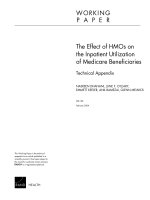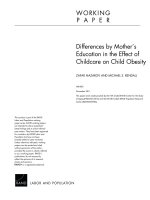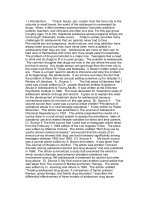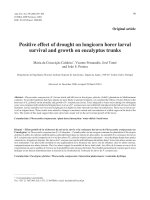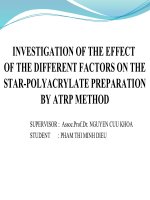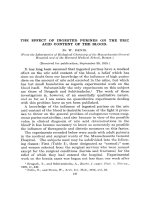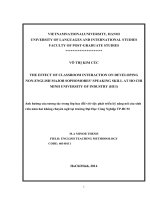Effect of weather parameters on population dynamics of mustard aphid
Bạn đang xem bản rút gọn của tài liệu. Xem và tải ngay bản đầy đủ của tài liệu tại đây (218.67 KB, 6 trang )
Int.J.Curr.Microbiol.App.Sci (2019) 8(4): 1648-1653
International Journal of Current Microbiology and Applied Sciences
ISSN: 2319-7706 Volume 8 Number 04 (2019)
Journal homepage:
Original Research Article
/>
Effect of Weather Parameters on Population Dynamics of Mustard Aphid
Sevak Das1*, D.N. Tejani2, J.C. Patel1, A.G. Desai2, A. I. Desai1 and G.P. Gangwar2
1
Department of Agricultural Meteorology, C. P. College of Agriculture
2
Castor-Mustard Research Station, S. D. Agricultural University,
Sardarkrushinagar- 385 506, India
*Corresponding author
ABSTRACT
Keywords
Aphid, Mustard
and weather
Article Info
Accepted:
12 March 2019
Available Online:
10 April 2019
To assess the impact of weather parameters on mustard aphid, a field experiment was
conducted during Rabi season 2011-12 to 2017-18 at Main Castor-Mustard Research
Station, S.D. Agricultural University, Sardarkrushinagar. The experiment was laid down in
randomized block design consisting five varietal treatments viz. BSH-1, GSC-6, T-27, GS1 and GDM-4 with three replications. The crop was sown during 24th – 30th Sept as timely
sown crop and 15th – 21st Oct as late sown crop. The results revealed that the maximum
incidence of aphid was observed in late sown crop as compared to early sown crop. The
correlation study between aphid population and weather parameters revealed that the
maximum temperature (Tmax), minimum temperature (Tmin) and growing degree days
(GDD) had significant negative correlation with aphid population. Morning relative
humidity, evening relative humidity, sunshine hours and wind speed did not have
significant correlation with aphid population. The regression models were developed with
Tmax and GDD could explain 72 to 87 percent variation in aphid population in different
cultivars.
Introduction
Rapeseed mustard (Brassica Spp.) is the
second most important oil seed crop of the
country after groundnut which contributes
about 25-30% of total oil seeds production. In
India, it is mainly cultivated in Rajasthan,
Uttar Pradesh, Madhya Pradesh, Bihar,
Assam, Gujarat, Maharashtra, Haryana and
West Bengal in various agro-ecological
situations. Mustard is a cool season crop and
cultivated in the tropical as well as in the
temperate climates. In spite of fact, Indian
mustard plays an important role in agriculture
economy due to growing under diverse
conditions. However, the mustard average
yields in our country yet low as compared to
other countries due to many constraints like
delay sowing, pest diseases incidence and
others management practices. Among
different insect pest of mustard, aphid
infestation is one of the major problems and
widely distributed throughout the world. It
causes damage directly by sucking the
phloem from the different parts of the plants
(Ali and Rizvi, 2007). The population
dynamics of this pest considered to be highly
influenced by prevailing weather condition
particularly
temperature
and
relative
humidity. Several studies have been indicated
1648
Int.J.Curr.Microbiol.App.Sci (2019) 8(4): 1648-1653
that weather plays an important role on the
aphid
appearance,
multiplication
and
disappearance (Srivastava and Srivastava,
1972; Roy, 1975; Jitendra Kumar et al., 1999;
Srivastava, 1999; Vekaria and Patel, 2000).
The efforts have been made by Prasad and
Phadke (1984); Rana et al., (1993) to
correlate the temperature and relative
humidity
with
the
incidence
and
multiplication of aphid in the mustard crop.
The changes in aphid population with change
in weather parameters enable to forecast the
population of mustard aphid under changing
scenarios of climate using statistical
approaches.
The study would be helpful to challenge the
pest by manipulating the manageable
ecological parameters like planting or
harvesting
time
adjustment,
varietals
selection, timely application of insecticides
etc. Statistical forewarning models is the best
approach that would be helpful to provide the
information regarding incidence of pest in an
advance based on medium range weather
forecast and such information would be
incorporate in Agromet advisory bulletins of
the GKMS project. Thus, an attempt has been
made to quantify the relationship between
weather
parameters
and
appearance,
development of aphids in mustard crop at
Sardarkrushinagar.
Materials and Methods
A field experiment was conducted on mustard
crop during Rabi season 2011-12 to 2017-18
at Main Castor-Mustard Research Station,
Sardarkrushinagar Dantiwada Agricultural
University, Sardarkrushinagar to find out the
impact of weather on population dynamic of
mustard aphid. Geographically, the location is
situated at 24.19o N latitude and 72.19o E
longitude at an altitude of 154.5m above
mean sea level having arid to semi-arid
climate. The experiment was laid down in
randomized block design consisting five
varietal treatments viz. BSH-1, GSC-6, T-27,
GS-1 and GDM-4 with three replications. The
crop was sown during 24th – 30th Sept as
timely sown crop and 15th – 21st Oct as late
sown crop. The plots were maintained
following the recommended agronomic
practices in same manner for all the
treatments. The all plots were kept free from
any insecticidal spray throughout the crop
period. The number of aphids per 10 cm of
the main shoot of the 10 pre-labeled randomly
selected plants from each plot was counted at
weekly interval from the day of aphid
appearance in the field and then was
averaged.
The daily meteorological parameters like
maximum temperature (Tmax), minimum
temperature (Tmin), morning relative
humidity (RH1), evening relative humidity
(RH2), sunshine hours (SSH), wind speed
(WS) and growing degree days (GDD) were
recorded
at
the
Agro-meteorological
observatory of SDAU located in the
Agronomy Instructional Farm and then
converted into weekly basis against the
standard meteorological week (SMW) with
correspondence to weekly population of
aphid. Gowning degree days (GDD) was
calculated by considering base temperature as
5.0 0C following Chakravarty and Sastry
(1983). The pooled data of aphid population
over the years was taken for the correlation
and regression analysis. The weekly
population of aphid was considered as
dependent variable and correlated with
corresponding weekly weather parameters as
independent variables. On the bases of
significant correlation coefficients between
aphid population and weather variables,
stepwise regression study was performed to
develop statistical forewarning models.
Statistical Package for Social Science (SPSS)
computer software version 20 was used for
correlation and regression analysis.
1649
Int.J.Curr.Microbiol.App.Sci (2019) 8(4): 1648-1653
Results and Discussion
Population dynamics of mustard aphid
In timely sown crop (24-30 Sept), the
appearance of aphid was started during 9th
week after sowing. While in late sown crop
(15-21 Oct), it was appeared during 6th week
after sowing. However, the appearance of
aphid was seen simultaneously in both sowing
dates when weekly maximum and minimum
temperatures were 31.0 0C and 13.5 0C
respectively. Thereafter, the population of
pest increased further with decreasing of
temperature. The incidence increased rapidly
from 14th week after sowing in timely sown
crop and peak population (256 aphids per
shoot) was recorded in cultivar GSC-6 during
17th week after sowing (Fig. 1). Thereafter,
the population of aphid was found to decrease
and remain active up to 23rd week after
sowing. Similarly, the incidence increased
rapidly from 11th week after sowing in late
sown crop and peak population (455 aphids
per shoot) was recorded in cultivar GDM-4
during 15th week after sowing (Fig. 2).
Thereafter, it was decreased gradually and
disappeared during 23rd week after sowing.
The maximum activity of aphid was remained
in between 15th – 20th week after sowing (1st –
6th SMW) in timely sown crop and 12th – 19th
week after sowing (1st – 8th SMW) in late
sown crop respectively. It may be due to the
prevailing
maximum
and
minimum
temperatures during peak activity of aphid
found congenial for aphid multiplication.
Thus, in late sown crop, all cultivars infested
relatively more as compared to timely sown
crop. The incidence of aphid was found less
in cultivar T-27 in both timely and late sown
crop as compared to other cultivars.
The appearance of aphid started three week
earlier in late sown crop as compared to
timely sown crop. Malik and Sachan (2013)
also reported that incidence of mustard aphid
started in the third week of December and
reaching peak population in the second week
of February. Basiva et al. (2018) observed
that, the aphid population started right from
flowering to maturity of crop and initial
population was comparatively low but as the
temperature decreased, the population
multiplied very fast.
Correlation between mustard aphid and
weather parameters
In order to find out the association between
aphid population and different weather
parameters correlation study was performed
between weekly aphid population and
corresponding weekly weather parameters.
Since, the incidence of aphid was seen
simultaneously in both sowing dates, the
population of aphid was averaged with
respective cultivars and used for correlation
study. The correlation coefficients between
aphid population and weather parameters
presented in Table 1. The results revealed
that, maximum temperature (Tmax) minimum
temperature (Tmin) and growing degree days
(GDD) had significant negative correlation
with aphid population in all cultivars. Highest
correlation coefficient was obtained with
Tmax followed by GDD. Morning relative
humidity (RH1), evening relative humidity
(RH2), sunshine hours (SSH) and wind speed
(WS) did not have significant correlation with
aphid population. However, correlation
coefficient was positive with RH1, RH2, and
WS while it was negative with SSH.
Thus, the maximum and minimum
temperatures found most influencing weather
parameters in the present study.
As the maximum and minimum temperatures
decreased, the multiplication of aphid
population was found increased. Gami et al.,
(2002)
observed
significant
negative
correlation of aphid population with
1650
Int.J.Curr.Microbiol.App.Sci (2019) 8(4): 1648-1653
maximum and minimum temperature. Ahuja
(1990) also observed negative association
with maximum, minimum temperatures and
sunshine hours with aphid population. Singh
and Singh (1986) observed positive effect of
the maximum and minimum temperature,
morning relative humidity and evening
relative humidity and sunshine hours on the
population of mustard aphid.
Forewarning models for mustard aphid
The biological responses like insect
populations are influenced not only by a
single weather variable, but by the interaction
effect of more than one variable. Hence,
multiple regression models were developed
based on significant correlation coefficients
between aphid population and weather
variables by using stepwise regression method
for predicting aphid population.
Since, the aphid population highly
significantly correlated with maximum
temperature (Tmax) minimum temperature
(Tmin) and growing degree days (GDD).
Thus, the regression models were developed
with Tmax and GDD. The developed models
could explain 72 to 87 percent variation in
aphid population in different cultivars (Table
2). These models are simple and easy in
calculation and could be used to predict aphid
population in mustard crop well in advance.
Thus, based on the predictions from such
models under changing scenarios of climate,
pest population could be managed efficiently
through ecological manageable practices like
timely application of insecticides, adjustment
of sowing time and selection of varieties etc.
that would be helpful to obtained higher yield.
Table.1 Correlation coefficient between aphid population and weather parameter
Weather
parameter
Cultivar
BSH-1
GSC-6
T-27
GS-1
GDM-4
Tmax
-0.857**
-0.896**
-0.781**
-0.896**
-0.889**
Tmin
-0.665**
-0.709**
-0.579*
-0.732**
-0.723**
RH1
0.387
0.413
0.366
0.433
0.434
RH2
0.093
0.129
0.036
0.168
0.174
SSH
-0.371
-0.340
-0.395
-0.352
-0.418
WS
0.235
0.254
0.240
0.240
0.195
-0.667**
-0.711**
-0.581**
-0.736**
-0.726**
GDD
*Significant at 5% level **Significant at 1% level
Table.2 Forewarning models for mustard aphid for different cultivars
Cultivar
BSH-1
GSC-6
T-27
GS-1
GDM-4
Forewarning models
Y = 1800.821 – 73.895Tmax + 4.070GDD
Y = 2095.464 – 84.628Tmax + 4.343GDD
Y = 940.547 – 40.098Tmax + 2.500GDD
Y = 1300.502 – 41.114Tmax
Y = 1327.458 – 42.126Tmax
1651
R squire
0.82
0.87
0.72
0.80
0.79
Int.J.Curr.Microbiol.App.Sci (2019) 8(4): 1648-1653
Fig.1 Population of mustard aphid in timely sown crop at Sardarkrushinagar
Fig.2 Population of mustard aphid in late sown crop at Sardarkrushinagar
The results of present finding may be
concluded that, incidence of mustard aphid
was found vary with sowing dates. Late sown
crop was suffered with much incidence of
aphid as compared to timely sown crop.
Weather parameters like Tmax, Tmin and
GDD were found to significant influence on
initiation and development of aphid in the
present study. With decreased of temperature
the multiplication of aphid was found
increased. Thus, the developed models with
Tmax and GDD caused 72 – 87% variation in
aphid population and could be used to predict
aphid incidence in mustard crop.
References
Ahuja, D.B. 1990. Population dynamics of
mustard aphid Lipaphis erysimi (Kalt.)
on Indian mustard, Brassica juncea
1652
Int.J.Curr.Microbiol.App.Sci (2019) 8(4): 1648-1653
(subsp. juncea). Indian J. Plant Prot.
18(8): 233-35.
Ali, A and P.Q. Rizvi, 2007. Development
and predatory performance of
Coccinella septempuncutata L. on
different aphid species. J. Biol. Sci., 7:
1478-1483.
Bavisa, R., Parmar, G.M., Hirapara, M.M.
and Acharya, M.F. 2018. Population
dynamics of mustard aphid, Lipaphis
erysimi (Kaltenbach) on mustard in
relation
to
different
weather
parameters.
Journal
of
Pharmacognosy and Phytochemistry
2018; 7(4): 394-396.
Chakravarty, N.V.K. and Sastry, P.S.N. 1983.
Biomass production in wheat relation
to evaporative demand and ambient
temperature. Mausam 34(3): 323-327.
Gami, L.M., J.G. Bapodra, RR. Rathod. 2002.
Population dynamics of mustard aphid
Lipaphis erysimi (Kaltenbach) in
relation to weather parameters. Indian
Journal of Plant Protection 30: 20204.
Jitendra Kumar, Y.P. Malik and S.V. Singh.
1999. Forecasting models for outbreak
of Lipaphis erysimi on some cultivars
of mustard, Brassica juncea. Ind. J
Entomol. 61 (1): 59-64.
Malik R, Sachan SK. Population build up of
mustard, Lipaphis erysimi (Kalt.) on
indian mustard in relation to some
abiotic
factors.
Progressive
Agriculture. 2013; 13(1):153-157.
Prasad, S.K., K.G. Phadke, K.N. Mehrotra.
1984. Forecasting of mustard aphid,
Lipaphis erysimi (Kaltenbach) on
rapeseed crop. Proc. Indian Nat. Sci.
Acad. (B) 50:146–153.
Rana,J.S., Khokhar,K.S., Singh, H. and
Suchetra 1993. Influence of abiotic
environment on the population
dynamics of mustard aphid Liphaphis
erysimi (Kalt.) Crop Res. Hisar, 6(1):
116-119.
Roy, Pranab. 1975. Population dynamics of
mustard aphid, Lipaphis erysimi
(Kaltenbach) (Aphididae: Hemiptera)
in West Bengal. Indian J. Ent. 37(3):
318-321.
Singh, H. and B. Singh. 1986. In: Proc. Nath.
Conf. on key pests of agricultural
crops, held at C.D.A. University of
Agric. & Tech., Kanpur, from 21-23
December, 1985, Pp. 117-123.
Srivatsava, A. 1999. Effect of date of sowing
and varieties on the incidence of
mustard aphid, Lipaphis erysimi
(Kalt.) on rapeseed mustard. J.
Oilseeds Res. 16(2): 380-381.
Srivatsava, A.S. and J. L. Srivatsava. 1972.
Ecological studies on aphid, painted
bug and saw fly attacking mustard and
rape in India. F.A.O. Plant Prot. Bull.
20:136-140.
Vekaria, M.V. and G.M. Patel 2000.
Screening of promising Brassica and
allied genotypes for resistance against
mustard aphid, Lipaphis erysimi Kalt.
(Homoptera: Aphididae). Applied
Biol. Res. 4 (1-2): 75-77.
How to cite this article:
Sevak Das, D.N. Tejani, J.C. Patel, A.G.Desai, A.I. Desai and Gangwar, G.P. 2019. Effect of
Weather Parameters on Population Dynamics of Mustard Aphid. Int.J.Curr.Microbiol.App.Sci.
8(04): 1648-1653. doi: />
1653
